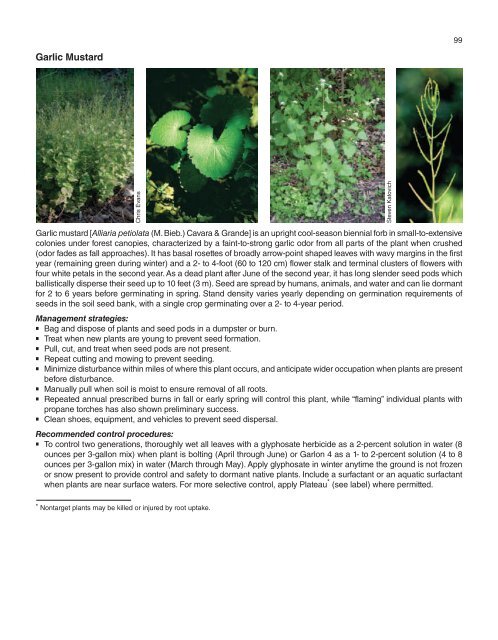A Management Guide for Invasive Plants in Southern Forests James ...
A Management Guide for Invasive Plants in Southern Forests James ...
A Management Guide for Invasive Plants in Southern Forests James ...
- No tags were found...
You also want an ePaper? Increase the reach of your titles
YUMPU automatically turns print PDFs into web optimized ePapers that Google loves.
99Garlic MustardChris EvansSteven KatovichGarlic mustard [Alliaria petiolata (M. Bieb.) Cavara & Grande] is an upright cool-season biennial <strong>for</strong>b <strong>in</strong> small-to-extensivecolonies under <strong>for</strong>est canopies, characterized by a fa<strong>in</strong>t-to-strong garlic odor from all parts of the plant when crushed(odor fades as fall approaches). It has basal rosettes of broadly arrow-po<strong>in</strong>t shaped leaves with wavy marg<strong>in</strong>s <strong>in</strong> the firstyear (rema<strong>in</strong><strong>in</strong>g green dur<strong>in</strong>g w<strong>in</strong>ter) and a 2- to 4-foot (60 to 120 cm) flower stalk and term<strong>in</strong>al clusters of flowers withfour white petals <strong>in</strong> the second year. As a dead plant after June of the second year, it has long slender seed pods whichballistically disperse their seed up to 10 feet (3 m). Seed are spread by humans, animals, and water and can lie dormant<strong>for</strong> 2 to 6 years be<strong>for</strong>e germ<strong>in</strong>at<strong>in</strong>g <strong>in</strong> spr<strong>in</strong>g. Stand density varies yearly depend<strong>in</strong>g on germ<strong>in</strong>ation requirements ofseeds <strong>in</strong> the soil seed bank, with a s<strong>in</strong>gle crop germ<strong>in</strong>at<strong>in</strong>g over a 2- to 4-year period.<strong>Management</strong> strategies:Bag and dispose of plants and seed pods <strong>in</strong> a dumpster or burn.Treat when new plants are young to prevent seed <strong>for</strong>mation.Pull, cut, and treat when seed pods are not present.Repeat cutt<strong>in</strong>g and mow<strong>in</strong>g to prevent seed<strong>in</strong>g.M<strong>in</strong>imize disturbance with<strong>in</strong> miles of where this plant occurs, and anticipate wider occupation when plants are presentbe<strong>for</strong>e disturbance.Manually pull when soil is moist to ensure removal of all roots.Repeated annual prescribed burns <strong>in</strong> fall or early spr<strong>in</strong>g will control this plant, while “flam<strong>in</strong>g” <strong>in</strong>dividual plants withpropane torches has also shown prelim<strong>in</strong>ary success.Clean shoes, equipment, and vehicles to prevent seed dispersal.Recommended control procedures:To control two generations, thoroughly wet all leaves with a glyphosate herbicide as a 2-percent solution <strong>in</strong> water (8ounces per 3-gallon mix) when plant is bolt<strong>in</strong>g (April through June) or Garlon 4 as a 1- to 2-percent solution (4 to 8ounces per 3-gallon mix) <strong>in</strong> water (March through May). Apply glyphosate <strong>in</strong> w<strong>in</strong>ter anytime the ground is not frozenor snow present to provide control and safety to dormant native plants. Include a surfactant or an aquatic surfactantwhen plants are near surface waters. For more selective control, apply Plateau * (see label) where permitted.* Nontarget plants may be killed or <strong>in</strong>jured by root uptake.
















